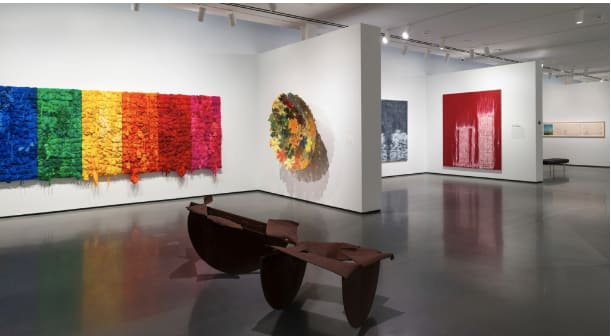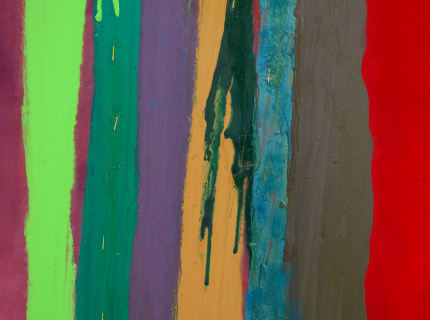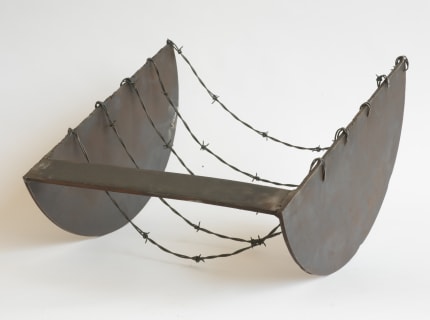SINCE 1999, PAMELA J. JOYNER and Alfred J. Giuffrida have focused their collecting on abstract art by artists of African descent. Nearing 100 artists, the collection is documented in a hefty volume, “Four Generations: The Joyner / Giuffrida Collection of Abstract Art,” and a traveling exhibition.
After touring four museums, “Solidary & Solitary: The Joyner/Giuffrida Collection” arrived at the Baltimore Museum of Art expanded and transformed. The new version of the exhibition is titled “Generations: A History of Black Abstract Art.” Presented as a series of conversations, duets, and solo shows, the exhibition tells a fascinating story about the lineage of black artists who since the post-war era have chosen to express themselves through abstraction.
A formidable group opens the show: Jack Whitten, Martin Puryear, Mark Bradford, and Julie Mehretu. Bradford and Puryear presented back-to-back solo shows in the American Pavilion at the Venice Biennale, in 2017 and 2019, respectively. A major traveling, mid-career survey of Mehretu opened recently at the Los Angeles County Museum of Art. At auction, works by Mehretu are the most expensive by a black woman, living or dead. Whitten, whose broader acclaim came in his final years, had a solo show at the Baltimore museum in 2018, occupying on his own the same space where works by 29 artists are now on view.
Their careers contrast with the experience of Norman Lewis, a celebrated painter with seven works installed in the next gallery. Lewis has been described as an “under-appreciated protagonist in the story of Abstract Expressionism.” In his lifetime, he never received the acclaim lavished on his white peers. Today, curators and major museums recognize his critical contributions. Joyner describes Lewis as the “entry point” to the Joyner/Giuffrida Collection.
Generations” presents a spectrum of artists whose works make powerful personal, political, and aesthetic statements. Works by the likes of Lewis, Alma Thomas, Whitten, Frank Bowling, Sam Gilliam, Joe Overstreet, Ed Clark, Melvin Edwards, David Hammons, Glenn Ligon, Jennie C. Jones, Lorna Simpson, Bradford, Leonardo Drew, and Kevin Beasley are drawn from the Joyner/Giuffrida Collection. Additions from the Baltimore Museum of Art and other institutions and collectors by Puryear, Mehretu, Al Loving, Howardena Pindell, and Barbara ChaseRiboud, among others, help showcase a more comprehensive, intergenerational history of black abstract art.
Christopher Bedford (Director of the Baltimore Museum of Art) mentioned in his opening remarks at the press preview that in 2016 it was a challenge to get museums to sign on to the traveling exhibition. I’ve heard that about a number of black exhibitions over the years, that there’s always this challenge to get institutions to take the show. From what he said, that’s changing some. Can you talk about how the landscape has changed from when you began this exhibition to now?
The other exhibition that famously ran into the same situation was “Soul of a Nation.” Of course, with my involvement with Tate, I’ve been very involved with “Soul of a Nation” from the outset of its conception. I just think that there is now more knowledge created around what is a true history. The history is the history. It happened. The issue was revealing the substance and importance of the history.
In the past you’ve heard me, or read things I’ve said, about how important I think the curatorial community is and I couldn’t even re-emphasize that more. More and more curators have unearthed and revealed more and more information about these makers and as that happens people are continuing to develop an appreciation for how significant these artists are.
Let’s just use, for instance, Jack Whitten as an example. I think between 2016 and today there’s a lot fuller understanding of how important Jack was to the canon. He was important to the canon in 1970, but nobody knew it. But now we’ve unpacked more and more of that history. Revealed more and more of that history. As that happened, museums have wanted to do what their business is, which is tell those stories.
...
Read full interview at culturetype.com.




